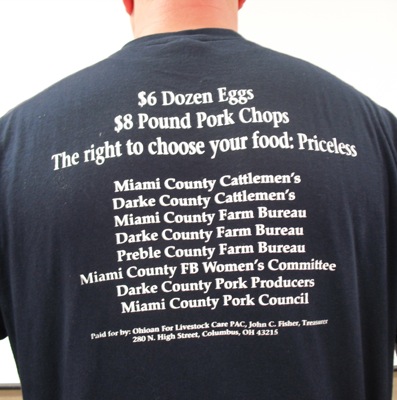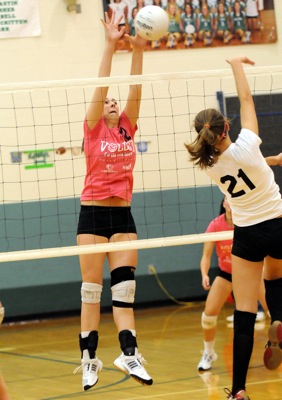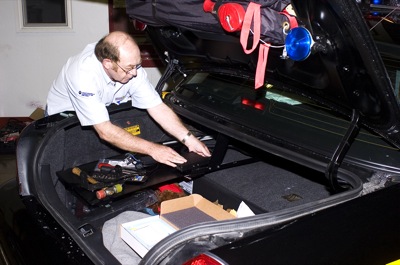Friday, October 2nd, 2009
Farmer seeks help to pass Issue II
By Nancy Allen

Photo by Nancy Allen/The Daily Standard
Jeff Wuebker, president of the Ohio Soybean Association, shows his shirt supporting Ohio Issue II.
Support is building behind Ohio Issue II, which if passed by voters in November, would form a 13-member Livestock Care Standards board, but more work is needed to get the word out, especially to those in big cities, an area ag officials said.
Jeff Wuebker, a Darke County hog farmer and president of the Ohio Soybean Association, spoke about the issue during Thursday's monthly ag breakfast meeting in Celina. The board would have authority to set standards for the care and welfare of livestock and poultry in the state.
Wuebker has been traveling the state fielding questions about the issue and educating the nonfarming public about why farm animals are housed they way they are, an issue the board would look at if created.
Last week he spoke before editorial boards at newspapers in Columbus, Toledo, Akron and Cleveland. The boards help a newspaper decide weather or not to endorse a particular issue or candidate.
Wuebker said during the editorial boards, he and other ag officials debated different types of livestock confinement with officials from the Humane Society of the United States (HSUS), a well-funded animal rights group not affiliated with local cat and dog shelters, whose real mission is promoting a meatless lifestyle.
The HSUS months ago said it would put a ballot issue before Ohio voters to try to ban battery cages for laying chickens, gestation crates for sows and crates for veal. In response, the Ohio legislature passed a resolution to place Ohio Issue II- an amendment to the state's constitution - on the November ballot.
"That group (nonfarmers) does not understand animal care and why we went to stalls 40 years ago," Wuebker said of his visit with the big city newspapers' editorial boards. "There's a reason I don't want my sows to turn around. It's because they fight and bite each other."
Wuebker further explained that 10 to 14 days before a pregnant sow gives birth, her vulva swells to the size of a grapefruit and that's the first place another sow will attack another sow if they are housed together and not separated in gestation crates.
During one editorial board debate, Wuebker said he got HSUS officials to agree that they did not support dog fighting or cock fighting.
"But yet they want to make it legal to have sow fighting every day," Wuebker said. "They didn't have an answer to that."
HSUS successfully fought for passage of Proposition 2 in California last November. The law, which takes effect in 2015, requires that veal calves, pregnant sows and hens used for commercial egg production must be given enough space to lie down, stand up, fully extend their limbs and turn around without touching other animals or their enclosure. Though the law affects pregnant pigs and veal calves, the majority of animals that will be affected are California's nearly 20 million egg-laying hens.
Studies show the new law will cost California egg farmers millions to build more enclosures that house fewer birds and cause egg farmers to leave the state. Studies also showed the new confinement law would increase the cost of food.
The outcome in Ohio wouldn't be any different, Wuebker said, putting a particular strain on smaller, family farms, many of which exist in Mercer and Darke counties.
Ohio's egg production, valued at $483 million in 2007, ranks second only to Iowa's, the 2007 USDA Census of Agriculture says. Mercer and Darke counties ranked first and second respectively in the state for income from hogs. In poultry and eggs, Darke County ranked first in the state and Mercer County ranked second.
Wuebker said western Ohio farmers and ag officials have been generous in raising money to promote Issue II, as have a number of grain commodity groups. The Ohio Grocer's Association, Ohio Restaurant Association and food banks have all endorsed Issue II, he said.
But HSUS is forming a political action committee (PAC) to raise money to promote its agenda. Even if Issue II passes, HSUS could still put on a ballot initiative in 2010 if it gathers enough signatures to ban certain types of animal confinement, he said.
Wuebker urged those attending Thursday's breakfast meeting to give to the campaign to support Issue II and tell friends and family to do the same.
Support Issue II signs also are available and can be obtained by contacting your local county Farm Bureau office, he said.
The next monthly breakfast meeting is 7:30 a.m. Nov. 5 in the first floor conference room at the Mercer County Central Services Building in Celina.
The issue:
If passed in Ohio, the chairman of the board would be the director of the Ohio Department of Agriculture (ODA). The board would be made up of 10 members appointed by the governor with the advice and consent of the Senate.
The 10 governor- appointed members must be residents of Ohio and will include: one member representing family farms; one member knowledgeable about food safety in Ohio; two members representing statewide organizations that represent farmers; one member who is a veterinarian licensed in Ohio; the ODA state veterinarian; the dean of the agriculture department of a college or university located in Ohio; two members of the public representing Ohio consumers and one member representing a county humane society organized under Ohio law.
Rounding out the board would be two more members - one appointed by the speaker of the house of representatives who is a family farmer and one appointed by the president of the senate who is a family farmer.
Not more than seven members appointed to the board at any given time shall be of the same political party, the resolution reads.



